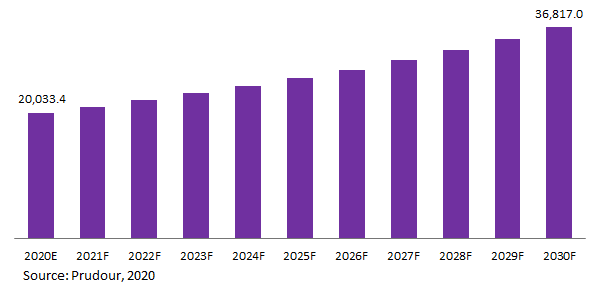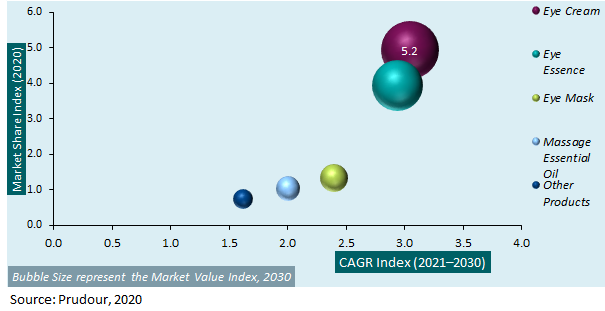Global Eye Skin Care Market By Type (Eye Cream, Eye Essence, Eye Mask, Massage Essential Oil, and Other), By Application (Specialist Retailers, Factory Outlets, Internet Sales, and Other), By Region, and Key Companies - Industry Segment Outlook, Market Assessment, Competition Scenario, Trends and Forecast 2023-2033
- Published date: July 2023
- Report ID: 56687
- Number of Pages: 304
- Format:
- keyboard_arrow_up
Quick Navigation
Global Eye Skin Care Market Overview:
Market.US announces the publication of its most recently generated research report titled, “Global Eye Skin Care Market by Product Type (Eye Cream, Eye Essence, Eye Mask, Massage Essential Oil, Other Products), By Distribution Channel (Specialist Retailers, Factory Outlets, Internet Sales, Other Distribution Channel), and by Region – Global Forecast to 2032.”, which offers a holistic view of the global eye skin care market through systematic segmentation that covers every aspect of the target market.
Cosmetics and other personal care products are used to clean, beautify, and enhance attractiveness or change appearances. The skin around the eyes is much thinner than the skin on an individual’s face and more susceptible to environment-based agents such as ultraviolet rays and other related elements.
Specialized cosmetics are required for the skin around the eyes. Eye skin care products include eye creams, eye masks, eye essences, etc., that are only meant to be used on the fragile skin surrounding the eyes. Eye creams are specially manufactured and are thicker than facial lotions, as well as contain more emollients and effective conditioners
The increase in demand for eye skin care products from both men and women is expected to promote revenue growth for this target market. Dark circles and the occurrence of puffiness affects both men and women, and is more common in adults, and rare among children. In addition, for an increasing number of working men and women, eye creams are an important part of daily skin and eye care routines.
This is another factor that is expected to further promote revenue growth. Rapid urbanization, increased income levels, changing consumer lifestyles, a booming retail sector, the increasing availability of reputable and popular beauty brands, as well as increased spending by individuals on various cosmetics is leading to improved sales figures.
Drivers:
- There are several factors that are driving the growth of the eye skin care market. One of the major factors is the increasing awareness about the importance of eye skin care and its benefits. This has resulted in a growing demand for eye care products, such as eye creams, gels, and serums.
- Additionally, the rise in aging population and the increasing concerns about the appearance of fine lines, dark circles, and wrinkles around the eyes are also driving the growth of the market.
- Another factor is the growing popularity of non-invasive and minimally invasive cosmetic procedures, such as Botox injections and chemical peels, which are being increasingly used for eye skin care.
- The rise in disposable income and changing lifestyle patterns, especially among urban consumers, is also contributing to the growth of the market. The increasing popularity of online shopping and the availability of a wide range of eye skin care products at competitive prices are also driving the growth of the market.
Restraining Factors:
- There are several factors that can act as restraints for the growth of the eye skin care market. One of the major factors is the high cost of eye skin care products, especially premium and high-end products.
- This can limit the adoption of these products among price-sensitive consumers. Another factor is the lack of standardization in the production of eye skin care products, which can lead to inconsistencies in quality and efficacy.
Global Eye Skin Care Market Revenue (USD Mn), 2020–2030

These are complementary factors that are expected to further fuel the demand for eye skin care products in the cosmetics industry. However, several ingredients used in eye creams, such as fragrances, preservatives, resins, emollients, and antioxidants, may irritate the surface of the eyes, and result in inflammation of the eyes. This factor is expected to hinder the demand for eye skin products.
The global eye skin care market is segmented on the basis of product type, distribution channel, and region. Under the segmentation of product, the eye cream segment is expected to account for the majority revenue share of this target market, as a result of increasing demand levels for eye cream owing to its beneficial properties. Specialist retailers are expected to have a major revenue share in this market, owing to its easy availability in almost every region.
On the basis of region, the European market is estimated to account for a major share of the global eye skin care market, in terms of revenue, and is projected to maintain its respective market position over the forecast period. The market in Europe is expected to retain its respective position in terms of production capacity and consumption of cosmetics products owing to changing lifestyles and is projected to continue to complement the revenue growth of the overall market in this region.
Global Eye Skin Care Market Attractiveness Analysis by Product Type, 2021–2030

Market Segmentation:
Based on Product Type
- Eye Creams
- Eye Essences
- Eye Masks
- Massage Essential Oils
- Other Products
Based on Distribution Channel
- Specialist Retailers
- Factory Outlets
- Internet Sales
- Other Distribution Channels
Based on Region
- North America
- Europe
- Asia-Pacific
- South America
- Middle East & Africa
Key Players
- Procter & Gamble Company
- Unilever plc
- L’Oréal S.A
- Colgate-Palmolive
- The Estée Lauder Companies Inc.
- Kao Corp
- Shiseido Co. Ltd
- Beiersdorf AG
- Avon Products Inc
- Eye Care Cosmetics
For the Eye Skin Care Market research study, the following years have been considered to estimate the market size:
Attribute Report Details Market Size in 2022
USD 1.6 bn
Growth Rate
6.9%
Forecast Value in 2032
USD 3.4 bn
Historical Years
2016-2020
Base Year
2021
Estimated Year
2022
Short Term Projection Year
2028
Projected Year
2023
Long Term Projection Year
2032
Report Coverage
Competitive Landscape, Revenue analysis, Company Share Analysis, Manufacturers Analysis, Volume by Manufacturers, Key Segments, Key company analysis, Market Trends, Distribution Channel, Market Dynamics, COVID-19 Impact Analysis, strategy for existing players to grab maximum market share, and more.
Regional Scope
North America, Europe, Asia-Pacific, South America, Middle East & Africa
Country Scope
United States, Canada and Mexico, Germany, France, UK, Russia and Italy, China, Japan, Korea, India and Southeast Asia, Brazil, Argentina, Colombia etc.Saudi Arabia, UAE, Egypt, Nigeria and South Africa

- Procter & Gamble Company
- Unilever Plc Company Profile
- L’Oréal S.A. Company Profile
- Colgate-Palmolive
- The Estée Lauder Companies Inc.
- Kao Corporation Company Profile
- Shiseido Co. Ltd
- Beiersdorf AG
- Avon Products Inc
- Eye Care Cosmetics
- settingsSettings
Our Clients
| Single User $4,599 $3,499 USD / per unit save 24% | Multi User $5,999 $4,299 USD / per unit save 28% | Corporate User $7,299 $4,999 USD / per unit save 32% | |
|---|---|---|---|
| e-Access | |||
| Report Library Access | |||
| Data Set (Excel) | |||
| Company Profile Library Access | |||
| Interactive Dashboard | |||
| Free Custumization | No | up to 10 hrs work | up to 30 hrs work |
| Accessibility | 1 User | 2-5 User | Unlimited |
| Analyst Support | up to 20 hrs | up to 40 hrs | up to 50 hrs |
| Benefit | Up to 20% off on next purchase | Up to 25% off on next purchase | Up to 30% off on next purchase |
| Buy Now ($ 3,499) | Buy Now ($ 4,299) | Buy Now ($ 4,999) |










